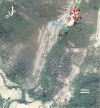Assessment of the ecological risk and mobility of arsenic and heavy metals in soils and mine tailings from the Carmina mine site (Asturias, NW Spain)
- PMID: 38367139
- PMCID: PMC10874346
- DOI: 10.1007/s10653-023-01848-6
Assessment of the ecological risk and mobility of arsenic and heavy metals in soils and mine tailings from the Carmina mine site (Asturias, NW Spain)
Abstract
An evaluation of the pollution, distribution, and mobility of arsenic and heavy metals in spoil heaps and soils surrounding the abandoned Carmina lead-zinc mine (Asturias, northern Spain) was carried out. Fractionation of arsenic was performed by an arsenic-specific sequential extraction method; while, heavy metal fractionations was carried out using the protocol of the Bureau Community of Reference (BCR) (now renamed Standards, Measurements and Testing Programme). Arsenic appeared predominantly associated with amorphous iron oxyhydroxides. Among the heavy metals, lead and zinc showed high availability since significant amounts were extracted in the nonresidual fractions; whereas, chromium, copper and nickel showed very low availability, indicating their lithogenic origins. The results showed that the extractability of heavy metals in soils is influenced mainly by the presence of iron and manganese oxides as well as by pH and Eh. Multiple pollution indices, including the enrichment factor (EF), geoaccumulation index (Igeo), ecological risk index (Er) and potential ecological risk index (PERI), were used to assess the degree of soil pollution in the mine area. All results showed that lead was the key factor causing the pollution and ecological risk in the studied area, and copper, zinc and arsenic also had significant contributions. Notably, the sites at higher risk coincided with those with high availability of arsenic and heavy metals. This study provides an integrative approach that serves as a powerful tool to evaluate the metal pollution status and potential threats to the local environment of abandoned mining areas, and the results are useful for making management decisions in these areas.
Keywords: Abandoned mines; Arsenic; Ecological risk assessment; Fractionation; Heavy metals; Mobility.
© 2024. The Author(s).
Conflict of interest statement
The authors have no relevant financial or nonfinancial interests to disclose.
Figures










Similar articles
-
Assessment of soil contamination by heavy metals and arsenic in Tamesguida abandoned copper mine area, Médéa, Algeria.Environ Monit Assess. 2022 Dec 29;195(1):247. doi: 10.1007/s10661-022-10862-7. Environ Monit Assess. 2022. PMID: 36580146
-
Pollution characteristics and environmental availability of toxic elements in soil from an abandoned arsenic-containing mine.Chemosphere. 2022 Sep;303(Pt 3):135189. doi: 10.1016/j.chemosphere.2022.135189. Epub 2022 May 31. Chemosphere. 2022. PMID: 35660392
-
Ecological evaluation of heavy metal pollution in the soil of Pb-Zn mines.Ecotoxicology. 2022 Mar;31(2):259-270. doi: 10.1007/s10646-021-02505-3. Epub 2022 Jan 4. Ecotoxicology. 2022. PMID: 34981243
-
Spatiotemporal variation of soil heavy metals in China: The pollution status and risk assessment.Sci Total Environ. 2023 May 1;871:161768. doi: 10.1016/j.scitotenv.2023.161768. Epub 2023 Feb 3. Sci Total Environ. 2023. PMID: 36740051 Review.
-
A global meta-analysis of heavy metal(loid)s pollution in soils near copper mines: Evaluation of pollution level and probabilistic health risks.Sci Total Environ. 2022 Aug 20;835:155441. doi: 10.1016/j.scitotenv.2022.155441. Epub 2022 Apr 22. Sci Total Environ. 2022. PMID: 35469881 Review.
Cited by
-
Health and ecological risk of heavy metals in agricultural soils related to Tungsten mining in Southern Jiangxi Province, China.PeerJ. 2024 Apr 1;12:e17200. doi: 10.7717/peerj.17200. eCollection 2024. PeerJ. 2024. PMID: 38577416 Free PMC article.
-
Exploring environmental risk in soils: Leveraging open data for non-sampling assessment?Heliyon. 2024 Dec 15;11(1):e41247. doi: 10.1016/j.heliyon.2024.e41247. eCollection 2025 Jan 15. Heliyon. 2024. PMID: 39811301 Free PMC article.
-
Understanding heavy metal contamination in the vicinity of Lake Urmia, NW Iran: Environmental and health Perspectives.Heliyon. 2024 Jul 5;10(13):e34198. doi: 10.1016/j.heliyon.2024.e34198. eCollection 2024 Jul 15. Heliyon. 2024. PMID: 39071674 Free PMC article.
-
Three local plants adapt to ecological restoration of abandoned lead-zinc mines through assembly of rhizosphere bacterial communities.Front Microbiol. 2025 Feb 10;16:1533965. doi: 10.3389/fmicb.2025.1533965. eCollection 2025. Front Microbiol. 2025. PMID: 39996083 Free PMC article.
-
Arsenic and vanadium co-exposure induced cerebellar neurotoxicity: aggravates apoptosis, inflammation, oxidative stress, and locomotor deficits in juvenile BALB/c mice.Anat Cell Biol. 2025 Jun 30;58(2):229-246. doi: 10.5115/acb.24.116. Epub 2025 Mar 26. Anat Cell Biol. 2025. PMID: 40134090 Free PMC article.
References
-
- Akoto R, Anning AK. Heavy metal enrichment and potential ecological risks from different solid mine wastes at a mine site in Ghana. Environmental Advances. 2021;3:100028. doi: 10.1016/j.envadv.2020.100028. - DOI
-
- Aldmour ST, Burke IT, Bray AW, Baker DL, Ross AB, Gill FL, Cibin G, Ries ME, Stewart DI. Abiotic reduction of Cr(VI) by humic acids derived from peat and lignite: Kinetics and removal mechanism. Environmental Science and Pollution Research. 2019;26(5):4717–4729. doi: 10.1007/s11356-018-3902-1. - DOI - PMC - PubMed
-
- Álvarez R, Ordóñez A, Loredo J. Geochemical assessment of an arsenic mine adjacent to a water reservoir (León, Spain) Environmental Geology. 2006;50(6):873–884. doi: 10.1007/s00254-006-0259-4. - DOI
-
- Álvarez-Benedí J, Bolado S, Cancillo I, Calvo C, García-Sinovas D. Adsorption-desorption of arsenate in three spanish soils. Vadose Zone Research. 2005;4(2):282–290. doi: 10.2136/vzj2004.0095. - DOI
MeSH terms
Substances
LinkOut - more resources
Full Text Sources
Medical

